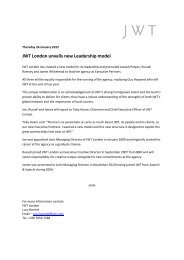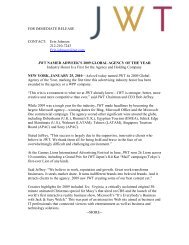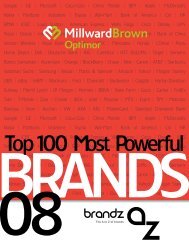Building Brands from the Inside Out - WPP.com
Building Brands from the Inside Out - WPP.com
Building Brands from the Inside Out - WPP.com
- No tags were found...
Create successful ePaper yourself
Turn your PDF publications into a flip-book with our unique Google optimized e-Paper software.
EMPLOYEEENGAGEMENTBUILDING BRANDS FROM THE INSIDE OUT
1THE FOUR CATEGORIESOF ENGAGEMENTConsider <strong>the</strong> average <strong>com</strong>pany. Assume that <strong>the</strong> ideal employee is someone whoboth understands what <strong>the</strong> <strong>com</strong>pany is trying to do and is emotionally <strong>com</strong>mittedto helping it succeed. What proportion of employees do you think fall into this category?80%? 60%? 40%?Well, keep lowering your estimate. In <strong>the</strong> average <strong>com</strong>pany, this type of employee—called a brand champion—is outnumbered more than two to one by o<strong>the</strong>r types ofemployees. Some employees—<strong>the</strong> loose cannons—may care about what <strong>the</strong> <strong>com</strong>panyis trying to do but don’t know what to do about it. O<strong>the</strong>rs—<strong>the</strong> bystanders—knowwhat <strong>the</strong> <strong>com</strong>pany is trying to do but don’t care. And still o<strong>the</strong>rs—<strong>the</strong> weak links—nei<strong>the</strong>r know nor care. To make matters worse, in <strong>the</strong> average <strong>com</strong>pany <strong>the</strong>se weaklinks make up <strong>the</strong> biggest group—almost 40%¹ (see <strong>the</strong> Enterprise IG Buy-in Matrixon page 2).That’s <strong>the</strong> bad news. The good news is that this means most <strong>com</strong>panies havetremendous upside potential. What would happen if <strong>the</strong>y could find a way to turn<strong>the</strong> loose cannons, which number about 30%, into brand champions? How would<strong>the</strong> atmosphere and performance change if <strong>com</strong>panies found a way to turn <strong>the</strong>weak links into <strong>com</strong>mitted, knowledgeable employees?IN THE AVERAGE COMPANY, BRANDCHAMPIONS ARE OUTNUMBERED MORETHAN TWO TO ONE BY OTHER TYPESOF EMPLOYEES.Internal <strong>com</strong>munications, internal marketing, internal branding—call it what youwill—<strong>the</strong> idea that it’s important to get employee buy-in to <strong>com</strong>pany goals andstrategies has been around for decades. Vast amounts of time, money and efforthave been expended trying to motivate employees, to create cultures and <strong>com</strong>paniesthat really zing with energy and enthusiasm. Yet, over this time, things haveactually gotten worse. According to one survey, only 19% of employees think <strong>the</strong>iremployers involve <strong>the</strong>m in open, effective <strong>com</strong>munication.²ENTERPRISE IG BUY-IN MATRIXIllustration: Christoph NiemannHowever, it is possible to get it right. Look at any outstanding corporate successstory over <strong>the</strong> past few decades, and somewhere along <strong>the</strong> line you’ll find that itspeople policies—its ability to engage its employees and earn <strong>the</strong>ir <strong>com</strong>mitment—play a crucial role in its success.³ Compare Southwest Airlines and its counterpartsin <strong>the</strong> U.S. airline industry, for example. Or Tesco and standard retail practices in<strong>the</strong> U.K. Or Toyota and <strong>the</strong> fallen giants of <strong>the</strong> U.S. motor industry—General Motorsand Ford—both now boasting junk bond status for <strong>the</strong>ir debts.Whe<strong>the</strong>r it’s cause or effect is a moot point. Almost certainly it’s a <strong>com</strong>bination of<strong>the</strong> two. The fact is, organizations that create and nurture brand champion employees
ISSUES No. 3 3TOGETHER, THE TWO INGREDIENTSOF INTELLECTUAL CONNECTION ANDEMOTIONAL COMMITMENT ARE THEKEYS TO ENGAGEMENT.perform better. In one U.K. cable <strong>com</strong>pany we worked with, for example, <strong>the</strong>proportion of brand champions more than doubled, <strong>from</strong> 22% to 53%, over 12months. After a three-month lag, its customer churn began to fall dramatically,adding significantly to <strong>the</strong> bottom line. Ano<strong>the</strong>r client, a leading U.K. retailer witha 57% brand champion employee rate, has consistently outperformed <strong>the</strong> U.K. stockmarket. How do such <strong>com</strong>panies achieve <strong>the</strong>se figures?AT WHAT IS IS ENGAGEMENT?Being engaged is something special. Your mind is alert and absorbed. Your emotionsare heightened. Your attention is focused, and your behavior is channeled. Trueengagement, <strong>the</strong>n, is about behavior. It’s not <strong>the</strong> same as, say, “satisfaction,”which is passive. That’s why familiar and overused measures such as employeesatisfaction actually tell us nothing about how engaged people are. 4 Likewise,engagement is not about awareness or familiarity with a particular message.Internal branding, internal marketing and internal <strong>com</strong>munications are all importantsupporting acts in brand engagement. But if left alone simply as <strong>com</strong>munications,<strong>the</strong>y merely scratch <strong>the</strong> surface.FAMILIAR AND OVERUSED MEASURESSUCH AS EMPLOYEE SATISFACTIONACTUALLY TELL US NOTHING ABOUT HOWENGAGED PEOPLE ARE.Real engagement goes much fur<strong>the</strong>r. The first thing it does is encourage on-brandbehavior. What this means will vary greatly, depending on employees’ roles. Theyneed a deep understanding of what <strong>the</strong> brand stands for, and what this means for<strong>the</strong>ir daily activities. This underlies <strong>the</strong> first of engagement’s two essential ingredients:intellectual connection. That is, knowing what, why and how.The second thing engagement does is motivate people. Think of all <strong>the</strong> qualities<strong>com</strong>panies truly value employees for. The creativity and imagination that lead toproblem solving, innovation and growth. Or <strong>the</strong> sense of purpose that gets <strong>the</strong>mworking toge<strong>the</strong>r in <strong>the</strong> same direction, as teams, even when <strong>the</strong> going gets tough.What unites <strong>the</strong>se examples is that <strong>the</strong>y cannot be specified, <strong>com</strong>manded or controlledin a job description. Yet when employees bring <strong>the</strong>m to work, <strong>the</strong> <strong>com</strong>pany zingswith energy. This is <strong>the</strong> second key ingredient of engagement: emotional <strong>com</strong>mitment.HEARING, BELIEVING AT IS ENGAGEMENT?AND LIVINGENTERPRISE IG BUY-IN MATRIXNote: The percentages above represent average proportions of champions, bystanders,loose cannons and weak links. Source: Enterprise IG Buy-in Benchmark research, 2005.Illustration: Christoph NiemannToge<strong>the</strong>r, <strong>the</strong> two ingredients of intellectual connection and emotional <strong>com</strong>mitmentare <strong>the</strong> keys to engagement. So why does it happen so rarely? Engagement happenswhen employees hear <strong>the</strong> message,believe <strong>the</strong> message, and <strong>the</strong>nlive or act upon it.
ISSUES No. 3 5But bringing intellectual connection and emotional <strong>com</strong>mitment toge<strong>the</strong>r, in <strong>the</strong> rightway, through all <strong>the</strong>se stages isn’t easy. In fact, it’s easier to get it wrong than it isto get it right. Let’s consider some of <strong>the</strong> pitfalls, starting with <strong>the</strong> absolute basics.First, it’s not possible to devise a robust engagement program if managers don’tunderstand <strong>the</strong>ir current performance. That’s why analyzing current employeeattitudes and segmenting employees into <strong>the</strong> four categories of engagementoutlined earlier is a good starting point.ENTERPRISE IG BUY-IN BENCHMARKSOur research across global organizations over <strong>the</strong> past five years has shown largevariations in <strong>the</strong> levels of engagement. The number of champions in any <strong>com</strong>panycan range <strong>from</strong> as low as 8% to as high as 72%.CHAMPIONS KNOW AND CARE 8% 72%BYSTANDERS KNOW BUT DON’T CARE 1% 17%LOOSE CANNONS CARE BUT DON’T KNOW 12% 47%WEAK LINKS NEITHER KNOW NOR CARE 8% 63%Source: Enterprise IG Buy-in Benchmark research, 2000-2005;75,000 employees across 25 multi-national organizations.LOWHIGH36% OF COMPANIES HAVE A DEDICATEDPROGRAM OR INITIATIVE FOREMPLOYEE ENGAGEMENT.16% OF THOSE SURVEYED BELIEVEEMPLOYEE ENGAGEMENT LEVELS ARE HIGH.EMPLOYEE ENGAGEMENT REPORT, MELCRUM PUBLICATION, 2004The fact is, most <strong>com</strong>panies are still not good at <strong>com</strong>municating with <strong>the</strong>ir employees.This is where marketing skills are essential. People turn off <strong>from</strong> monologues, but<strong>the</strong>y engage in conversations. Yet many corporate <strong>com</strong>munications simply talk to,or at, employees ra<strong>the</strong>r than create a conversation with <strong>the</strong>m.A second pitfall is getting <strong>the</strong> mix of intellectual connection and emotional<strong>com</strong>mitment wrong. Employees need to have a clear and powerful view of what <strong>the</strong>yare part of and where <strong>the</strong> brand and business are going, why this is right, and how<strong>the</strong>y will get <strong>the</strong>re. Some <strong>com</strong>panies err on <strong>the</strong> side of too much emotion. They lovefiring up <strong>the</strong>ir employees with great and exciting missions and visions—but <strong>the</strong>yback this up with hardly any intellectual grounding. In <strong>the</strong> sober light of day, employeesdon’t really understand exactly what <strong>the</strong>y need to do or why. Great hopes.Few results.Such analysis can be sobering. It also helps to surface where and what <strong>the</strong>problems are. For example, one motor dealership found that a key department wasstaffed entirely by weak links and loose cannons, without a brand champion insight, while some of its o<strong>the</strong>r departments consisted mostly of brand champions.Research like this can quickly help identify where engagement challenges exist.The question, <strong>the</strong>n, is how to address <strong>the</strong>m.HEARINGFor engagement to work, employees must HEAR <strong>the</strong> message. Yet, in most <strong>com</strong>panies,many (if not most) employees don’t really know what <strong>the</strong>ir brand stands for,what <strong>the</strong> <strong>com</strong>pany is trying to achieve or how. The solution is simple, you mightsay. Just tell <strong>the</strong>m. Trouble is, in most <strong>com</strong>panies employees are already drowning ina sea of information and messages. A study in one <strong>com</strong>pany counted <strong>the</strong> number ofwords and numbers an employee received over <strong>the</strong> course of three months.The total was 2.3 million. This <strong>com</strong>pany was in <strong>the</strong> middle of a change program.How much information did <strong>the</strong> employee receive about <strong>the</strong> change program over <strong>the</strong>same three-month period? A total of 13,400 words and numbers. That’s lessthan 1% of <strong>the</strong> total—not enough to be noticed at all.O<strong>the</strong>r times, <strong>com</strong>panies present a <strong>com</strong>plete, irrefutable, watertight case fora particular course of action. Nobody in his or her right mind could disagree.And nobody does. But what’s missing is that all-important ingredient of inspiration.While <strong>the</strong> message touches <strong>the</strong> head, it leaves people’s hearts stone cold. Whatfrontline staff need here may be very different <strong>from</strong> what line managers need, andit differs by job role, professional qualification and geographical region. Themarketer’s art of audience segmentation is an essential skill if this mix ofintellectual and emotional engagement is to be achieved across <strong>the</strong> entireorganization, ra<strong>the</strong>r than in just parts of it. Perhaps even more important is whoemployees hear <strong>the</strong> messages <strong>from</strong>. The most important channel of all is o<strong>the</strong>rpeople. Especially line managers.There’s a real issue here, because managers are often <strong>the</strong> biggest obstacle tochange. A sine qua non for any successful attempt to engage employees is seniormanagement’s own engagement. If <strong>the</strong> organization’s leaders don’t see <strong>the</strong> effortas a genuine priority, <strong>the</strong>n frankly it’s probably not worth <strong>the</strong> bo<strong>the</strong>r. But even if<strong>the</strong>re is genuine buy-in at <strong>the</strong> top, <strong>the</strong> effort will never achieve real employeeengagement by itself.
ISSUES No. 3 7LIVINGIf line managers don’t be<strong>com</strong>e champions, <strong>the</strong> chances of employees joining<strong>the</strong>ir ranks are slim indeed. As soon as any message descends on rank-and-fileemployees “<strong>from</strong> <strong>the</strong> top,” <strong>the</strong> first thing <strong>the</strong>y do is look into <strong>the</strong> whites of <strong>the</strong>irown line managers’ eyes to see if <strong>the</strong>y genuinely believe it, if <strong>the</strong>y properlyunderstand it, if <strong>the</strong>y mean it. And it’s here that any disconnect between statedobjective and behavior—between word and deed—will be instantly spotted.IF THE CEO IS APPEALING OVER THEHEADS OF HIS OR HER LINE MANAGERSTO RANK-AND-FILE EMPLOYEES,HE OR SHE HAS PROBABLY ALREADYLOST THE BATTLE.That’s why LIVING <strong>the</strong> brand is so important. This is where <strong>the</strong> day-to-dayoperational implications of <strong>the</strong> brand message are embedded into <strong>the</strong> sinews of<strong>the</strong> organization: where <strong>the</strong> nitty-gritty of aligning work patterns and priorities,systems, policies, incentives, processes, structures and recognition systems takesover. To deliver a great brand experience to customers, employees must be supportedevery step of <strong>the</strong> way, with <strong>the</strong> right training, tools, processes, incentives, materials,management backup and so on. The U.K. bank First Direct stands out <strong>from</strong><strong>the</strong> crowd in terms of customer experience, satisfaction and word-of-mouthre<strong>com</strong>mendation. It’s no accident that First Direct recruits employees who fitwith its brand personality, and organizes its internal processes around helpingemployees deliver friendly, efficient service. The entire organization is clearlyaligned around what <strong>the</strong> brand stands for.Trouble is, line managers are often <strong>the</strong> hardest to convince. They’ve “seen it allbefore.” They can often see <strong>the</strong> disconnects between senior managers’ stated objectivesand <strong>the</strong>ir day-to-day behavior. Line managers want a peaceful life and areinclined to keep <strong>the</strong>ir heads down and wait for it all to blow over. So <strong>com</strong>municationprograms are just <strong>the</strong> start. Hearing without believing isn’t enough.BELIEVINGActions speak louder than words, and BELIEVING begins when actions provideevidence. Believing happens when <strong>the</strong> message be<strong>com</strong>es real for me, in my job,day-to-day. If engagement is all about behaviors ra<strong>the</strong>r than just attitudes, engagingpeople happens via <strong>the</strong> day job. This requires often painstaking dialogue about<strong>the</strong> implications of <strong>the</strong> brand at an individual and team level, where <strong>the</strong> day-to-daywork gets done.Most employees want to do a good job. Most frontline employees want to servecustomers well. What kills <strong>com</strong>mitment and engagement is when <strong>the</strong>se natural,positive desires are stymied by back-office systems that hinder ra<strong>the</strong>r than helpor policies that place employees in conflicting ra<strong>the</strong>r than win-win positions withcustomers. U.K. retailer Tesco has a simple acid test for all internal initiatives:simpler, better, cheaper. Is it simpler for employees, better for customers, andcheaper for <strong>the</strong> <strong>com</strong>pany? If it’s all three, <strong>the</strong>n do it. If it’s not, <strong>the</strong>n reconsider.Is <strong>the</strong>re a way to make it simpler, better and cheaper? When employees’ workexperiences change for <strong>the</strong> better, attitudes tend to change for <strong>the</strong> better. Changingattitudes without changing experiences is unsustainable.360˚ BRAND EXPERIENCE
ISSUES No. 3This is important because everything <strong>com</strong>municates, so <strong>com</strong>panies need 360˚<strong>com</strong>munication strategies. Every customer touchpoint is a <strong>com</strong>munication oppor-tunity, or disaster. Likewise with employees. For example, what message does <strong>the</strong><strong>com</strong>pany’s working environment send to employees about its “real” priorities andattitudes? Or its intranet, internal magazine, emails, guidelines, etc.?Exhorting frontline employees to “put <strong>the</strong> customer first” and <strong>the</strong>n creatingperformance management systems that penalize those who do is a classic butall-too-<strong>com</strong>mon mistake. Wrongly designed systems can be hugely demotivating.Even well-designed reward systems rarely motivate by <strong>the</strong>mselves. Positivemotivation often <strong>com</strong>es <strong>from</strong> o<strong>the</strong>r, more emotional things, such as <strong>the</strong> <strong>com</strong>pany’sreputation, pride in a job well done, status or a sense of identity or <strong>com</strong>munity.The brand needs to be reinforced throughout <strong>the</strong> employee journey to enable employeesto deliver a powerful brand experience to customers.KEEPING AT ITSUSTAINED COMMUNICATIONWhen it <strong>com</strong>es to employee engagement, <strong>the</strong>re are two words that should foreverbe kept apart: “<strong>com</strong>munication” and “campaign.” All too often, <strong>com</strong>panies turn onemployee <strong>com</strong>munication when <strong>the</strong>y feel <strong>the</strong>y really need it, and <strong>the</strong>n turn it offagain as o<strong>the</strong>r priorities seize <strong>the</strong>ir attention and <strong>the</strong>y get absorbed in <strong>the</strong>ir day job.They haven’t realized yet that continuous engagement is <strong>the</strong>ir day job. If engagementis just a campaign ra<strong>the</strong>r than “how we do things around here,” <strong>the</strong>n not only willit be ineffective, it may even be counterproductive. Why? Because campaigns andinitiatives that are seen not to work—especially after <strong>the</strong> first flushes of enthusi-asm—breed disappointment and cynicism. Conversely, nothing motivates likesuccess: tangible, visible evidence that things are getting better.RECOGNITION & REWARDThat’s why recognizing and celebrating successes is so important. Yes, manysalesperson-of-<strong>the</strong>-month style employee recognition programs are cheesy. But<strong>the</strong> best programs deliver a <strong>com</strong>pelling message about what <strong>the</strong> <strong>com</strong>pany is reallytrying to do. Take BP’s efforts to show employees that its <strong>com</strong>mitment to socialand environmental responsibility is for real and not just PR-inspired lipstick on<strong>the</strong> gorilla. BP’s Helios Awards highlight best-practice examples in ways that bothinspire employees and demonstrate sound down-to-earth business principles.One Helios Award winner was a three-year investment and development projectset up to help <strong>com</strong>munities in Azerbaijan, Georgia and Turkey that were affectedby BP’s Caspian pipeline developments. Just some of <strong>the</strong> long-term benefits for <strong>the</strong><strong>com</strong>munities include job and in<strong>com</strong>e generation; better farming yields; and improvedaccess to schools, medical facilities, irrigation, sanitation and drinking water. Thisproject, and o<strong>the</strong>rs like it that are recognized through <strong>the</strong> Helios Awards, reflectnew ways of working that can benefit <strong>the</strong> global BP <strong>com</strong>munity.Illustration: Christoph NiemannTHE EMPLOYEE JOURNEY
ISSUES No. 3 11CREATING ENGAGEMENTBut what about those weak links, loose cannons and bystanders? Is all this enoughto convert <strong>the</strong>m to true engagement? In some cases, <strong>the</strong> answer is no. Some weaklinks are so disengaged that it’s best for <strong>the</strong> two sides to part <strong>com</strong>pany. O<strong>the</strong>rtimes, weak links have <strong>the</strong> potential to be your biggest champions. They want tobelieve, but <strong>the</strong>y can’t. Often, it’s <strong>the</strong> organization, not <strong>the</strong> employee, that’s atfault. Ensuring that <strong>the</strong>re are <strong>com</strong>pelling and true reasons to believe can helpemployees on <strong>the</strong> journey to be<strong>com</strong>ing a champion. Often, however, what manyemployees actually experience are unconvincing lies or just muddling confusion.AT&T was once one of America’s biggest and most successful <strong>com</strong>panies. Today itssurvival is in doubt and its stock has junk bond status. Throughout its long decline,many attempts were made to launch “a new AT&T.” Dick Martin, former VP of publicrelations, employee <strong>com</strong>munications and brand management, recalls in his bookTough Calls how unsuccessful <strong>the</strong>y all were.5All <strong>the</strong> campaigns’ “focus had beenexternal,” he writes. “They were designed to convince <strong>the</strong> outside world that it hadunderestimated <strong>the</strong> <strong>com</strong>pany.”BP LENDING A HELPING HAND BY SUPPORTING LOCAL COMMUNITIESMEASUREMENTIt’s astonishing but true: When it <strong>com</strong>es to employee engagement, most <strong>com</strong>paniesdon’t consistently monitor <strong>the</strong> effectiveness of what <strong>the</strong>y do. They fail to askacid-test questions such as “Do employees really understand what <strong>the</strong>y should bedoing?” and “Do <strong>the</strong>y feel that positive changes are happening?” Or, if <strong>the</strong>y domonitor effectiveness, some <strong>com</strong>panies don’t do anything with <strong>the</strong> findings.34% OF COMPANIES HAVE ASTRATEGY FOR MEASURING INTERNALCOMMUNICATION.52% OF COMPANIES RUNNINGENGAGEMENT SURVEYS DO NOTSTATISTICALLY ANALYZE KEY DRIVERSAFFECTING ENGAGEMENT.EMPLOYEE ENGAGEMENT REPORT, MELCRUM PUBLICATION, 2004BP Photographic Services“Unless it is preceded by an effective internal campaign,” Martin states, “any suchpositioning program is built on sand. No one outside <strong>the</strong> <strong>com</strong>pany will believe a messagethat is not reflected in <strong>the</strong>ir experiences with <strong>the</strong> <strong>com</strong>pany. And no one inside <strong>the</strong><strong>com</strong>pany will believe a message that does not <strong>com</strong>port with what he sees on <strong>the</strong> jobevery day.” In o<strong>the</strong>r words, weak links are usually products of weak strategies, weakleadership and weak excuses.Sometimes, <strong>the</strong> very mechanics of brand engagement and internal <strong>com</strong>municationcause problems. To work, brand engagement needs to bring <strong>the</strong> CEO, Marketingand Human Resources toge<strong>the</strong>r for a <strong>com</strong>mon cause. But all too often it’s a triggerfor internal turf wars. Marketing, frustrated that employees aren’t delivering on <strong>the</strong>promises <strong>the</strong>y make to customers, wants to muscle in on HR’s patch. HR spies anopportunity to extend its influence beyond <strong>the</strong> routine of recruitment, training,and terms and conditions to be<strong>com</strong>e a “strategic” partner to <strong>the</strong> CEO. Jostling forpower immediately sabotages <strong>the</strong> very thing that’s needed to create engagement—mutually supporting alignment between different levels of management andacross silos.This is no trivial point. When business school researcher Jody Hoffer Gittell setout to understand what set Southwest Airlines apart <strong>from</strong> its U.S. <strong>com</strong>petitors,she found high levels of shared goals, shared knowledge and mutual respect. 6At American Airlines, mutual suspicion among groups of employees was endemic.As one employee remarked: “They all think <strong>the</strong>y’re better than each o<strong>the</strong>r. Gateand ticket agents think <strong>the</strong>y’re better than <strong>the</strong> ramp. The ramp think <strong>the</strong>y’re betterthan <strong>the</strong> cabin cleaners. The cabin cleaners look down on <strong>the</strong> building cleaners.”At Southwest, employee groups were all much more focused on helping one ano<strong>the</strong>rimprove <strong>the</strong> customer’s experience.
ISSUES No. 3 13NO TURNING BACKBut is engagement really that important? You bet it is. It’s more important than manyCEOs, HR Directors and Marketing Directors realize, even now, because it reflectsone of this century’s biggest changes in economic and <strong>com</strong>petitive dynamics.“EVERYONE IS RESPONSIBLE FORDELIVERING OUR BRAND POSITIONING,AND EVERYTHING WE DO EITHERBUILDS OR UNDERMINES THAT BRAND.”ARUN SARIN, CEO, VODAFONEIn an industrial-age economy, all that was needed for improved productivity was totie employees to <strong>the</strong>ir machines and make sure <strong>the</strong>y kept pace. If employees left<strong>the</strong>ir hearts and minds at home that was just fine, because hearts and minds gotin <strong>the</strong> way of <strong>the</strong>ir appendage-to-<strong>the</strong>-machine functions. But today, more and more<strong>com</strong>panies are realizing that it’s <strong>the</strong> things machines cannot do—things like peeringinto <strong>the</strong> future to imagine alternative possibilities, being creative, empathizing withano<strong>the</strong>r person’s feelings, being motivated and having a sense of purpose—thatenergize <strong>com</strong>panies and give <strong>the</strong>m a <strong>com</strong>petitive edge. 7 This realization is takingus in a new direction, toward increasing ra<strong>the</strong>r than reducing our dependence on<strong>the</strong> qualities of our people.360˚ EMPLOYEE ENGAGEMENT• CREATE AN ALLIANCE BETWEEN THE CEO, MARKETING, AND HR• CONNECT EMPLOYEES TO CUSTOMERS: PAINT SIMPLE, RELEVANT, INSPIRING PICTURES• FOCUS ON THE LINE MANAGERS• TRANSLATE THE BRAND PROMISE INTO RELEVANT AND MEANINGFUL BEHAVIORS• ENGAGE IN DIALOGUE, HAVE CONVERSATIONS AND SHARE STORIES• ALIGN THE EMPLOYEE EXPERIENCE WITH THE CUSTOMER EXPERIENCE• PROVIDE VISIBLE AND TANGIBLE SYMBOLS OF SUCCESS• LISTEN, MEASURE, RECOGNIZE AND REWARD<strong>Brands</strong> and engagement are part of this new direction. <strong>Brands</strong> are be<strong>com</strong>ing centralorganizing principles for organizations, providing a framework against which toapply and <strong>com</strong>municate customer insight, strategic goals and objectives, andorganizational initiatives. They act as a code of conduct and a guide to “<strong>the</strong> way wedo things around here.” They provide <strong>the</strong> intellectual and emotional answers to<strong>the</strong> three questions every organization has to answer: Where do we want to get to?Why do we want to get <strong>the</strong>re? And how can we do so?Brand is a verb, not a noun. It’s about what we do. We need engaged employees tobuild brands. We need brands to engage employees. Creating <strong>the</strong> right connectionbetween <strong>the</strong> two is an issue that no board can afford to ignore.1Based on Enterprise IG’s Buy-in Benchmark research on more than 75,000 employees across all levelsof seniority and all industry sectors.2Watson Wyatt survey, 2002.3According to a recent meta-analysis of hundreds of studies conducted on Organizational CitizenshipBehaviors (OCBs)—that is, extra-role or “beyond-<strong>the</strong>-job” behaviors that employees volunteer on top of <strong>the</strong>ircore job descriptions—<strong>the</strong>y can account for up to 25% of <strong>the</strong> variance in financial performance insuccessful <strong>com</strong>panies. Podsakoff, P.M.; MacKenzie, S.B.; Paine, J.B. & Bachrach, D.G. 2000 Journalof Management, Vol. 26, Issue 3, pp. 513-563.4In <strong>the</strong> U.K., <strong>the</strong> Accounting Standards Board is currently suggesting that <strong>com</strong>panies report on employeesatisfaction measures as part of <strong>the</strong> newly introduced Operating and Financial Reviews, or OFRs.Nice intentions, but a flawed move never<strong>the</strong>less.5Dick Martin, Tough Calls, American Management Association, 2004.6Jody Hoffer Gittell, The Southwest Airlines Way, McGraw-Hill, 2002.7See H.B. Cohen, 1998, The Performance Paradox, Academy of Management Executive, Vol. 12, Issue 3, p. 30.
ISSUES No. 3 5PLEASE LOOK AT THE FOLLOWING CHECKLISTS AND SELECT THE ONE THAT COMES CLOSESTTO YOUR ROLE. ANSWER THE QUESTIONS HONESTLY. IF YOU ANSWERED “YES” ONLY A FEWTIMES, YOU MIGHT WANT TO GIVE US A CALL.CEO QUESTIONS• Do you know, qualitatively and quantitatively, how <strong>com</strong>mitted your peopleare to your brand(s)?• Are you and your senior team clear about what your brand stands for, and could you allexplain it to your employees in a consistent, <strong>com</strong>pelling way?• If <strong>com</strong>mitment to on-brand behavior requires changes of you and your top team,would you be <strong>com</strong>mitted to making <strong>the</strong>m?• Are your Marketing and HR people talking to each o<strong>the</strong>r with a shared agenda rootedin a better experience for <strong>the</strong> customer/consumer?• Does employee engagement feature in your personal set of key priorities?MARKETING QUESTIONS• Are you convinced that all people in <strong>the</strong> organization, especially <strong>the</strong> customer-facingemployees, understand what you are trying to do with <strong>the</strong> brand and what it meansfor <strong>the</strong>m?• Is internal engagement one of <strong>the</strong> priorities in your brand plans, with a clear set ofmeasurable actions?• You meet with your agencies regularly. Do you also meet with HR colleagues and linemanagers to consider <strong>the</strong> implications of your brand promise for your employees?• Do you set aside a budget for internal brand engagement, recognizing it as a criticalpart of true 360˚ brand activation?HR QUESTIONS• Are you clear about <strong>the</strong> brand promise and its implications for different partsof <strong>the</strong> organization?• Do you have a reward and recognition program linked to on-brand behaviors?• Does on-brand behavior feature in employees’ key performance indicators?• Do you have regular meetings with Marketing colleagues and line managersto discuss <strong>the</strong> implications of your brand promise for different employee groups?• Are you measuring employee <strong>com</strong>mitment, not just employee satisfaction?
ISSUES No. 3
















